Fire safety should be a major concern for the business owner. A properly thought out fire safety plan will not only prevent the majority of fires from happening, it will also give yourself and your staff the knowledge to react accordingly if the worst does happen.
Here’s some factors to think about when creating a fire plan as part of your business’s risk assessment:
Do You Share a Building or Office Space?
If you share your business space with another company, it’s vitally important that you team up and discuss matters of fire safety together. Everyone in the building needs to be working from the same script when an emergency happens.
How Will the Alarm Be Raised?
Obviously if a person discovers a fire themselves, they need to activate a “break-glass” point. In most cases however, an automatic alarm will be doing this job. You need to test the alarm regularly and make sure staff are accustomed to the rehearsal procedure. Once you know your detection systems are working correctly, you then need to work out how the fire services will be alerted of an emergency.
Do Your Staff Understand Their Roles?
Every member of your staff should have a role during an emergency. Even if that role is simply to leave via a designated exit, it still needs to be understood. Some staff may need to help seasonal workers or unfamiliar guests to exits, and fire marshals need to be correctly trained and kept up to date with building changes.
Have You Identified the Escape Routes?
Make sure all your escape routes are clearly marked and left unblocked. Emergency lights should be tested, and in larger buildings, you may need to create multiple exit routes in your plan.
Have You Checked Your Fire Blankets and Extinguishers?
Very small fires could in theory be tackled by trained members of staff. Everyone needs to know where fire fighting equipment is located (and first aid supplies for that matter) and how to use it. Fire extinguishers must be regularly checked and serviced and care should be taken to make sure they are correctly mounted and not blocking exits.
Where Is Your Assembly Point?
www.sourcefire.com regularly train businesses on correct fire procedure, and recommend deciding upon a fire assembly point at the first opportunity: “Your staff should understand the concept of the assembly point, and should be trained to meet there during an emergency. Take a staff register to ensure everyone has escaped. If you employ a larger team, utilise managers to take the role call and report missing staff”.
Do You Conduct Regular Fire Drills?
Finally, all of the above points are wasted if you don’t conduct regular fire drills. You should do this annually at minimum, but ideal much more frequently to account for absent staff members. A fire drill ties together your safety plan and ensures all your staff understand the importance of learning the correct procedures for when a potential emergency happens.
By Harry Price
Harry Price is a guest blogger and personal trainer. He spends his free time playing football with his mates or hiking with his 3 dogs.



